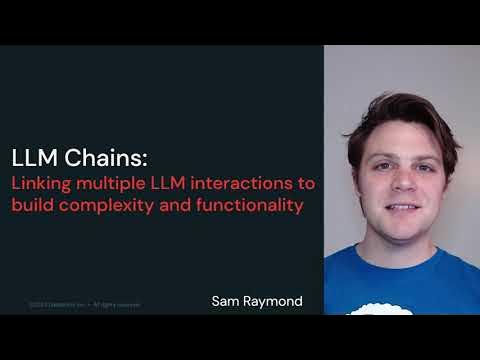Que sont les Grands Modèles de langage (LLM) ?
Summary
TLDRIn this video, we explore the world of Large Language Models (LLMs), essential tools for modern data scientists. LLMs are advanced AI programs capable of generating text, interpreting language, and performing tasks like sentiment analysis, code generation, and customer interaction. Powered by deep learning and neural networks, these models are trained on vast datasets to understand and produce human language. Their flexibility and open-source nature make them widely applicable across industries, from search engines to customer service. Despite their potential, LLMs rely on quality data, with limitations like occasional errors or vulnerabilities to manipulation.
Takeaways
- 😀 LLMs (Large Language Models) are powerful AI tools used for a variety of tasks, including text generation and language understanding.
- 😀 LLMs are trained on large text datasets and use deep learning, particularly neural networks, to process and generate human language.
- 😀 These models are crucial for many applications like code generation, customer service, sentiment analysis, and more.
- 😀 The quality of training data greatly impacts the performance of LLMs, influencing their ability to deliver accurate results.
- 😀 LLMs are open-source, allowing for flexible adaptation and integration into various fields, driving their increasing use in AI.
- 😀 They excel in tasks like answering questions, summarizing text, and generating content in a conversational manner.
- 😀 LLMs are used in search engines like Bing and Google to deliver relevant information by interpreting user queries contextually.
- 😀 They can also generate code and power interactive systems like chatbots and customer service agents, improving user engagement.
- 😀 The ability of LLMs to respond to unpredictable queries makes them more versatile than traditional programs that follow predefined interactions.
- 😀 Despite their power, LLMs can produce erroneous or fabricated answers if the training data is of poor quality or if they are manipulated.
Q & A
What is a Large Language Model (LLM)?
-A Large Language Model (LLM) is an AI program that excels in tasks such as text generation, trained on vast amounts of textual data. It uses machine learning principles, particularly neural networks, to understand and produce human language.
What role does deep learning play in LLMs?
-Deep learning is the foundation of LLMs, where the models analyze large data sets to identify complex patterns. This technique is based on neural networks that simulate the human brain's structure to process information through interconnected nodes.
How does the quality of training data affect an LLM's performance?
-The quality of the training data significantly influences the performance of an LLM. Better data leads to more accurate and reliable models, while poor data can lead to incorrect or misleading outputs.
What are some key applications of LLMs?
-LLMs are used in various fields, including text generation, customer service chatbots, sentiment analysis, code generation, and enhancing search engines like Google and Bing by providing relevant responses.
How does an LLM differ from traditional software applications?
-Unlike traditional software that follows pre-defined interactions, LLMs analyze human language to provide logical responses to unstructured queries, adapting to new or ambiguous contexts.
What is the role of transformers in LLMs?
-Transformers are a type of neural network model that uses self-attention mechanisms to understand and interpret sequences of data more effectively. They help LLMs comprehend context and produce more accurate responses.
Why are LLMs crucial for data scientists?
-LLMs are essential for data scientists as they enable efficient text generation, sentiment analysis, and natural language understanding, helping in tasks ranging from customer interaction to complex data processing.
Can LLMs produce errors or inaccurate information?
-Yes, LLMs can produce errors or even invent information, especially if the training data is of low quality. Their responses depend heavily on the data they are trained on, and they may occasionally provide unreliable outputs.
How do LLMs contribute to the development of generative AI?
-LLMs are a cornerstone of generative AI, allowing machines to create human-like text, code, or even art. They enable applications like ChatGPT, which can produce text in response to prompts, mimicking human writing styles.
What is the importance of LLMs in various sectors like healthcare or technology?
-LLMs are highly versatile and impact sectors such as healthcare, technology, science, and customer service. In healthcare, for example, they can assist in medical data analysis, while in technology, they enhance software development and automation.
Outlines

このセクションは有料ユーザー限定です。 アクセスするには、アップグレードをお願いします。
今すぐアップグレードMindmap

このセクションは有料ユーザー限定です。 アクセスするには、アップグレードをお願いします。
今すぐアップグレードKeywords

このセクションは有料ユーザー限定です。 アクセスするには、アップグレードをお願いします。
今すぐアップグレードHighlights

このセクションは有料ユーザー限定です。 アクセスするには、アップグレードをお願いします。
今すぐアップグレードTranscripts

このセクションは有料ユーザー限定です。 アクセスするには、アップグレードをお願いします。
今すぐアップグレード関連動画をさらに表示

What is Large Language Model (LLM)? | Artificial Intelligence Interview Questions & Answers

Roadmap to Learn Generative AI(LLM's) In 2024-Krish Naik Hindi #generativeai

LLM: A tecnologia por trás da IA textual - @CursoemVideo Inteligência Artificial

Introduction to large language models

LLM Module 3 - Multi-stage Reasoning | 3.4 LLM Chains

Lecture 3: Pretraining LLMs vs Finetuning LLMs
5.0 / 5 (0 votes)
